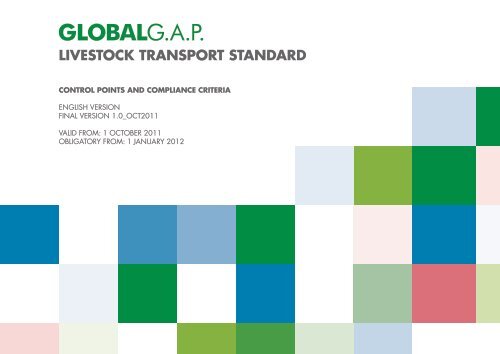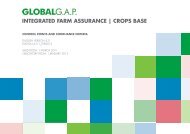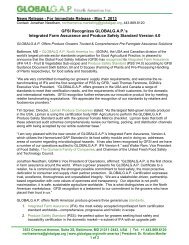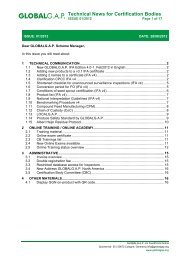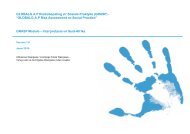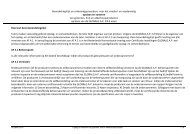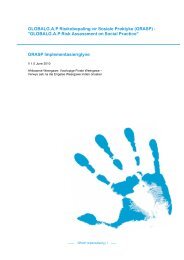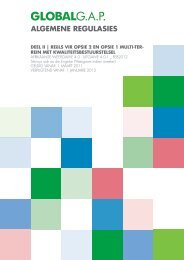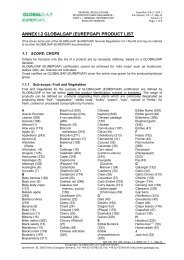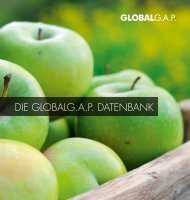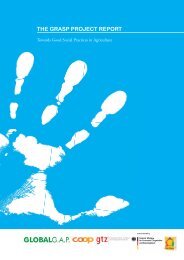CPCC Transport - GLOBALG.AP - GlobalGAP
CPCC Transport - GLOBALG.AP - GlobalGAP
CPCC Transport - GLOBALG.AP - GlobalGAP
You also want an ePaper? Increase the reach of your titles
YUMPU automatically turns print PDFs into web optimized ePapers that Google loves.
Livestock transport standard<br />
controL points and compLiance criteria<br />
ENGLISH VERSION<br />
FINAL VERSION 1.0_Oct2011<br />
VALId FROm: 1 OctObER 2011<br />
ObLIGAtORy FROm: 1 JANuARy 2012
111004_gg_cpcc_transport_eng_final_version_1_Oct11<br />
CONTENTS<br />
SECTION TRANSPORT MODULE<br />
1. TRANSPORT OPERATORS<br />
2. LEGISLATIVE FRAMEWORK<br />
3. DRIVERS<br />
4. VEHICLES<br />
5. TRANSPORTING PROCEDURES<br />
6. STOCKING RATES<br />
7. DOCUMENTATION, IDENTIFICATION AND TRACEABILITY<br />
8. ROADSIDE CHECKS<br />
9. JOURNEY PLANNING<br />
Control Points and Compliance Criteria<br />
<strong>Transport</strong><br />
ENGLISH VERSION<br />
10. ADDITIONAL TRANSPORT STANDARDS FOR POULTRY (N/A when no poultry transported)<br />
© Copyright: <strong>GLOBALG</strong>.A.P. c/o FoodPLUS GmbH,<br />
Spichernstr. 55, 50672 Köln (Cologne) Germany | Tel: +49-221-57993-25; Fax: +49-221-57993-89 |<br />
http://www.globalgap.org<br />
Code Ref: LT 1.0 –<strong>CPCC</strong><br />
Version: V1.0_Oct11<br />
Page: 2 of 31
111004_gg_cpcc_transport_eng_final_version_1_Oct11<br />
Control Points and Compliance Criteria<br />
<strong>Transport</strong><br />
ENGLISH VERSION<br />
© Copyright: <strong>GLOBALG</strong>.A.P. c/o FoodPLUS GmbH,<br />
Spichernstr. 55, 50672 Köln (Cologne) Germany | Tel: +49-221-57993-25; Fax: +49-221-57993-89 |<br />
http://www.globalgap.org<br />
Code Ref: LT 1.0 –<strong>CPCC</strong><br />
Version: V1.0_Oct11<br />
Page: 3 of 31<br />
Nº Control Point Compliance Criteria Level<br />
<strong>GLOBALG</strong>.A.P. LIVESTOCK TRANSPORT STANDARD<br />
<strong>Transport</strong> of all animals in the <strong>GLOBALG</strong>.A.P. Integrated Farm Assurance Scheme Section Livestock must only be carried out by <strong>GLOBALG</strong>.A.P. certified<br />
operators and their vehicles. This transport standard applies to all operators and vehicles transporting animals for a distance of over 65 km and under 65<br />
km for third party transport. Farmers transporting for distances less than 65 km must comply with requirements in Livestock Base Section 9 (Livestock<br />
Dispatch). This <strong>Transport</strong> standard applies to road vehicle transports; it excludes transports by airplanes and by ships except roll-on/roll-off ferries.<br />
1. TRANSPORT OPERATORS<br />
1.1 Is the operator transporting livestock in possession of a valid transporter<br />
authorization allowing the transport of farm animals and issued by the<br />
competent authority in the country where the operator is registered?<br />
Request a copy of valid transporter authorization approval for<br />
transportation of farm animals issued by the competent authority of the<br />
country, where the operator is registered.<br />
1.2 Has a contingency plan been formulated? Drivers on long journeys (over 8 hours) shall have a copy of the<br />
contingency plan. <strong>Transport</strong> under 8 hours driver will need to<br />
demonstrate that they are aware of the plan when asked. Plan to<br />
include at least emergency contact telephone numbers of owner of<br />
vehicle and emergency services.<br />
2. LEGISLATIVE FRAMEWORK<br />
2.1 Are all persons involved with the transport of livestock aware of and comply with<br />
any current National Legislation and Codes of Practice that apply to the<br />
movement of livestock?<br />
2.2 For journeys over 8 hours duration is there a completed journey log<br />
accompanying the animals?<br />
3. DRIVERS<br />
Interview on operator´s knowledge and visual assessment of<br />
compliance with national legislation and Codes of Practice.<br />
All persons that organize the transport must have at least a copy of<br />
<strong>GLOBALG</strong>.A.P. <strong>Transport</strong> Standards including any amendments.<br />
Visual inspection of journey log to make sure compliance with journey<br />
times, rest periods, feed and watering. Refer to Annexes 9, 10, 11.<br />
Major Must<br />
Major Must<br />
Major Must<br />
Major Must
111004_gg_cpcc_transport_eng_final_version_1_Oct11<br />
Control Points and Compliance Criteria<br />
<strong>Transport</strong><br />
ENGLISH VERSION<br />
© Copyright: <strong>GLOBALG</strong>.A.P. c/o FoodPLUS GmbH,<br />
Spichernstr. 55, 50672 Köln (Cologne) Germany | Tel: +49-221-57993-25; Fax: +49-221-57993-89 |<br />
http://www.globalgap.org<br />
Code Ref: LT 1.0 –<strong>CPCC</strong><br />
Version: V1.0_Oct11<br />
Page: 4 of 31<br />
Nº Control Point Compliance Criteria Level<br />
3.1 Are all persons transporting livestock in possession of the drivers Certificate of<br />
Professional Competence (CPC) required to transport livestock over 65 km?<br />
3.2 Can the person transporting the livestock demonstrate Best Practice when<br />
transporting livestock?<br />
4. VEHICLES<br />
4.1 Does the transport operator have a list of the vehicles used for livestock<br />
transports according to this standard?<br />
4.2 Has the owner of any vehicle or container used for transport ensured that the<br />
vehicle is fit for purpose and assured under the <strong>GLOBALG</strong>.A.P. Farm Assurance<br />
Livestock <strong>Transport</strong> Standard?<br />
4.3 Is the vehicle in use being maintained and kept in a condition which ensures that<br />
all animals can be transported in a manner so as not to cause them injury or<br />
unnecessary suffering and requirements?<br />
4.4 Do all the vehicles used for journeys over 8 hours comply with the additional<br />
provisions as required in the Annexes 2, 8 and 9?<br />
Visual inspection required - can be verified by the Certification Body<br />
approved by the competent authority that the person transporting<br />
livestock has the required qualifications under the <strong>GLOBALG</strong>.A.P.<br />
Standards.<br />
Refer to Annex 14.<br />
All training to be documented and available for inspection.<br />
Persons driving the vehicles shall be able at interview to confirm that<br />
they are aware of the content as laid down in Annex 14 and of special<br />
driving techniques when transporting livestock, e.g. careful acceleration<br />
and braking and awareness of road conditions.<br />
The transporter must have a list of vehicles used for livestock transports<br />
according to this standard, indicating type of vehicle and license plate<br />
number available.<br />
Check documents to confirm that the vehicle is assured according to<br />
this livestock transport standard and is fit for purpose according to<br />
Annexes 1, 4 and 8.<br />
Visual inspection to make sure all vehicles comply with the legislation.<br />
Requirements of Annex 1 must be installed.<br />
Maintenance records of vehicles must be available for inspection.<br />
Owner of transport company and drivers to show awareness of<br />
requirements by interview.<br />
Visual inspection of requirements as per Annexes 2, 8 and 9 for vehicles<br />
used for journeys over 8 hours.<br />
Major Must<br />
Major Must<br />
Major Must<br />
Major Must<br />
Major Must<br />
Major Must
111004_gg_cpcc_transport_eng_final_version_1_Oct11<br />
Control Points and Compliance Criteria<br />
<strong>Transport</strong><br />
ENGLISH VERSION<br />
© Copyright: <strong>GLOBALG</strong>.A.P. c/o FoodPLUS GmbH,<br />
Spichernstr. 55, 50672 Köln (Cologne) Germany | Tel: +49-221-57993-25; Fax: +49-221-57993-89 |<br />
http://www.globalgap.org<br />
Code Ref: LT 1.0 –<strong>CPCC</strong><br />
Version: V1.0_Oct11<br />
Page: 5 of 31<br />
Nº Control Point Compliance Criteria Level<br />
4.5 Do all the vehicles used for journeys less than 8 hours comply with additional<br />
provisions as required in the Annexes 2, 8 and 9?<br />
The vehicles used for journeys less than 8 hours should comply with<br />
additional provisions as required in the Annexes 2, 8 and 9?<br />
4.6 Do all vehicles have a source of ventilation as described in Annex 8? Ventilation must be capable of avoiding extreme conditions whilst taking<br />
into consideration the species and weather conditions as laid down in<br />
Annex 8.1 and 8.2.<br />
4.7 Do all vehicles have a temperature monitoring and recording system as<br />
described in Annex 8?<br />
5 TRANSPORTING PROCEDURES<br />
5.1 Are all persons involved in the transport of animals aware that it is prohibited to<br />
transport animals that are unfit, ill or injured?<br />
5.2 Are all loading and unloading facilities constructed, maintained and operated so<br />
that no injury or suffering can be caused to the livestock being moved?<br />
Visual inspection.<br />
Temperature monitoring and recording system must be installed as laid<br />
down in Annexes 8.3 and 8.4<br />
Visual inspection.<br />
The transporter must be aware of what constitutes an unfit animal as<br />
defined in Annex 3. Staff to demonstrate awareness of legislation by<br />
interview and reference to definitions in Annex 3, with special regards to<br />
timelines which refer to pregnant females and those that have given<br />
birth plus new born animals.<br />
Recom.<br />
Major Must<br />
Major Must<br />
Major Must<br />
Visual inspection to check compliance. Major Must<br />
5.3 Do all ramps used comply with the angles set in Annex 4? Visual inspection. Major Must<br />
5.4 Are all stock handled in a quiet and calm manner and is the driver handling the<br />
livestock aware of the requirements of Annex 5?<br />
Visual inspection must be done either at loading or at unloading.<br />
<strong>Transport</strong>er to demonstrate awareness of handling procedures.<br />
Refer to Annex 5.<br />
Major Must
111004_gg_cpcc_transport_eng_final_version_1_Oct11<br />
Control Points and Compliance Criteria<br />
<strong>Transport</strong><br />
ENGLISH VERSION<br />
© Copyright: <strong>GLOBALG</strong>.A.P. c/o FoodPLUS GmbH,<br />
Spichernstr. 55, 50672 Köln (Cologne) Germany | Tel: +49-221-57993-25; Fax: +49-221-57993-89 |<br />
http://www.globalgap.org<br />
Code Ref: LT 1.0 –<strong>CPCC</strong><br />
Version: V1.0_Oct11<br />
Page: 6 of 31<br />
Nº Control Point Compliance Criteria Level<br />
5.5 Are all vehicles cleansed and disinfected prior to loading and is the person<br />
transporting aware of the cleansing and disinfection requirements and is this<br />
documented?<br />
5.6 Does the person in charge of the transport have a list of disinfectant approved<br />
by the competent authority?<br />
5.7 Is suitable bedding material supplied at all times when transporting young<br />
animals according to Annexes 1 and 2?<br />
6. STOCKING RATES<br />
6.1 Are all stock transported in a manner so that they comply with stocking rates laid<br />
down in the Annex 6.<br />
6.2 Are all stock separated in accordance with the relevant Annex 7 and as required<br />
under the <strong>GLOBALG</strong>.A.P. Scheme?<br />
7. DOCUMENTATION, IDENTIFICATION AND TRACEABILITY<br />
Any person involved in the transport must demonstrate awareness of<br />
cleansing and disinfection of vehicles prior to loading and must have a<br />
written cleansing and disinfection record for the vehicle.<br />
Visual assessment.<br />
Visual assessment with the person in charge of the transport (= owner<br />
of vehicles/entrepreneur) for the availability of a list of disinfectant<br />
approved by the competent authority.<br />
Visual assessment; refer to Annex 1.5 and Annex 2.2.1.<br />
It is requested that straw must be used when transporting young<br />
animals.<br />
N/A Poultry and Turkey transports.<br />
Stocking rate to be verified by weight and number of animals and<br />
sqm: of floor space available<br />
<strong>Transport</strong> operator must show awareness at interview of separation of<br />
stock according to Annex 7.<br />
7.1 Has the person doing the transport completed an appropriate dispatch note? Visual checks of documentation and required details to be recorded.<br />
Dispatch note must include all criteria as outlined in Annex 12 and in the<br />
dispatch note in Annex 15.<br />
7.2 Are all animal identification documents required by the competent authority<br />
accompanying the livestock?<br />
All animal identification documents must be carried with the<br />
consignment and must be complete.<br />
Persons in charge must demonstrate awareness of requirements at<br />
interview.<br />
Major Must<br />
Recom.<br />
Major Must<br />
Major Must<br />
Major Must<br />
Major Must<br />
Major Must
111004_gg_cpcc_transport_eng_final_version_1_Oct11<br />
Control Points and Compliance Criteria<br />
<strong>Transport</strong><br />
ENGLISH VERSION<br />
© Copyright: <strong>GLOBALG</strong>.A.P. c/o FoodPLUS GmbH,<br />
Spichernstr. 55, 50672 Köln (Cologne) Germany | Tel: +49-221-57993-25; Fax: +49-221-57993-89 |<br />
http://www.globalgap.org<br />
Code Ref: LT 1.0 –<strong>CPCC</strong><br />
Version: V1.0_Oct11<br />
Page: 7 of 31<br />
Nº Control Point Compliance Criteria Level<br />
7.3 Are all movement documents required for the consignment available? All movement documents as required for the consignment according to<br />
Annex 12 must be available plus the Animal <strong>Transport</strong> Certificate (ATC)<br />
issued by the relevant authority. For<br />
transports performed outside EU N/A, in this case only dispatch note as<br />
outlined in Annex 15 required.<br />
7.4 Have different status of livestock been kept separate during transport i.e.<br />
<strong>GLOBALG</strong>.A.P. and Non-<strong>GLOBALG</strong>.A.P. approved livestock?<br />
8. ROADSIDE CHECKS<br />
8.1 Is the driver aware that he should ask the person in charge of roadside checks<br />
for priority in the interests of the welfare of the animals that are transported? Is<br />
he also aware of best practice if stopped for the purposes of complying with<br />
drivers hours regulations?<br />
9. JOURNEY PLANNING<br />
9.1 Is the journey from farm to the place of destination planned and undertaken<br />
without undue delay and has the welfare of the animals been considered?<br />
10. ADDITIONAL TRANSPORT STANDARDS FOR POULTRY (N/A when no poultry transported)<br />
10.1 Are any noise levels from any source minimized as much as possible during<br />
loading and unloading?<br />
10.2 Are all poultry of separate species or sex segregated by separate container for<br />
transport?<br />
Major Must<br />
Records must be checked – animals must be identified. Major Must<br />
Driver to demonstrate by interview awareness of best practice.<br />
e.g. parking in the shade.<br />
<strong>GLOBALG</strong>.A.P. Dispatch Note according to Annexe15 or equivalent<br />
documentation and any vehicle records must show times. Visual<br />
Assessment.<br />
Any persons involved in loading and unloading to demonstrate<br />
awareness.<br />
All poultry of a separate species or sex must be segregated by separate<br />
container for transport except male and female chicks.<br />
Checking by verification of transport records and visual checks<br />
N/A for mixed flocks of broiler chicken.<br />
Recom.<br />
Major Must<br />
Major Must<br />
Major Must
111004_gg_cpcc_transport_eng_final_version_1_Oct11<br />
Control Points and Compliance Criteria<br />
<strong>Transport</strong><br />
ENGLISH VERSION<br />
© Copyright: <strong>GLOBALG</strong>.A.P. c/o FoodPLUS GmbH,<br />
Spichernstr. 55, 50672 Köln (Cologne) Germany | Tel: +49-221-57993-25; Fax: +49-221-57993-89 |<br />
http://www.globalgap.org<br />
Code Ref: LT 1.0 –<strong>CPCC</strong><br />
Version: V1.0_Oct11<br />
Page: 8 of 31<br />
Nº Control Point Compliance Criteria Level<br />
10.3 Are all birds provided with sufficient space so as not to cause injury or<br />
unnecessary suffering?<br />
10.4 Are all birds only transported in suitable crates or containers specifically<br />
designed for the transport of poultry?<br />
Stocking density must be varied according to the birds weight, size and<br />
physical condition.<br />
Also the containers, weather and journey time must be taken into<br />
consideration.<br />
Visual checks to be made.<br />
Handlers to be aware of the requirements.<br />
Stocking density and feed and water supply as per Annex 13.<br />
All birds must be loaded into clean purpose built crates/containers.<br />
All crates/containers to be maintained and must prevent protrusion of<br />
any part of the birds.<br />
Handlers and person transporting must be aware of the <strong>GLOBALG</strong>.A.P.<br />
Requirements.<br />
Visual assessment to be undertaken.<br />
10.5 Are all birds being transported and protected against inclement weather? All birds that are transported must be protected against inclement<br />
weather. Most birds are susceptible to heat stress so leaving central<br />
passageway of empty crates can be advantageous particularly with the<br />
circulation of air. Lower stocking density shall always be considered.<br />
Spent hens can suffer from cold due to lack of feather cover.<br />
10.6 Is the driver aware that he must ask the person in charge of roadside checks for<br />
priority in the interests of the welfare of the animals being transported.<br />
Visual assessment must be made.<br />
Driver must demonstrate by interview awareness of best practice.<br />
e.g.: parking in the shade.<br />
Major Must<br />
Major Must<br />
Major Must<br />
Major Must
111004_gg_cpcc_transport_eng_final_version_1_Oct11<br />
Control Points and Compliance Criteria<br />
<strong>Transport</strong><br />
ENGLISH VERSION<br />
© Copyright: <strong>GLOBALG</strong>.A.P. c/o FoodPLUS GmbH,<br />
Spichernstr. 55, 50672 Köln (Cologne) Germany | Tel: +49-221-57993-25; Fax: +49-221-57993-89 |<br />
http://www.globalgap.org<br />
Code Ref: LT 1.0 –<strong>CPCC</strong><br />
Version: V1.0_Oct11<br />
Page: 9 of 31<br />
Nº Control Point Compliance Criteria Level<br />
10.7 Is poultry delivered to the abattoir in a clean condition? Visual checks of floors of crates/containers.<br />
Abattoir records to be checked of any recorded incidence of dirty<br />
poultry.<br />
10.8 Are all mortalities during transport recorded? Records on mortalities for every load to be recorded by the operator<br />
with feedback to the driver. All records and feedback procedures to be<br />
available for inspection.<br />
Major Must<br />
Major Must
111004_gg_cpcc_transport_eng_final_version_1_Oct11<br />
Control Points and Compliance Criteria<br />
<strong>Transport</strong><br />
ENGLISH VERSION<br />
ANNEXES OF <strong>GLOBALG</strong>.A.P. LIVESTOCK TRANSPORT STANDARD<br />
Table of content:<br />
ANNEX 1 PROVISIONS FOR ALL MEANS OF TRANSPORT<br />
ANNEX 2 ADDITIONAL PROVISIONS FOR LONG JOURNEYS<br />
ANNEX 3 FITNESS FOR TRANSPORT<br />
ANNEX 4 RAMPS<br />
ANNEX 5 HANDLING<br />
ANNEX 6 STOCKING RATES<br />
ANNEX 7 SEPARATION<br />
ANNEX 8 VENTILATION FOR MEANS OF TRANSPORT BY ROAD AND TEMPERATURE MONITORING<br />
ANNEX 9 NAVIGATION SYSTEM<br />
ANNEX 10 JOURNEY PLANNING<br />
ANNEX 11 JOURNEY TIMES AND REST PERIODS<br />
ANNEX 12 TRANSPORT DOCUMENTATION<br />
ANNEX 13 POULTRY<br />
ANNEX 14 DRIVER TRAINING<br />
ANNEX 15 <strong>GLOBALG</strong>.A.P. GUIDELINE FOR DISPATCH NOTE<br />
© Copyright: <strong>GLOBALG</strong>.A.P. c/o FoodPLUS GmbH,<br />
Spichernstr. 55, 50672 Köln (Cologne) Germany | Tel: +49-221-57993-25; Fax: +49-221-57993-89 |<br />
http://www.globalgap.org<br />
Code Ref: LT 1.0 –<strong>CPCC</strong><br />
Version: V1.0_Oct11<br />
Page: 10 of 31
111004_gg_cpcc_transport_eng_final_version_1_Oct11<br />
ANNEX 1 PROVISIONS FOR ALL MEANS OF TRANSPORT<br />
Control Points and Compliance Criteria<br />
<strong>Transport</strong><br />
ENGLISH VERSION<br />
1.1 All vehicles operating under the <strong>GLOBALG</strong>.A.P. Scheme must have been inspected and have a plate affixed to the animal container with dimensions<br />
and the available floor space.<br />
1.2 Means of transport, containers and their fittings shall be designed, constructed, maintained and operated so as to:<br />
(a) avoid injury and suffering and to ensure the safety of the animals;<br />
(b) protect the animals from inclement weather, extreme temperatures and adverse changes in climatic conditions;<br />
(c) be easily cleaned and disinfected;<br />
(d) prevent the animals escaping or falling out and be able to withstand the stresses of movements;<br />
(e) ensure that air quality and quantity appropriate to the species transported can be maintained;<br />
(f) provide access to the animals to allow them to be inspected and cared for;<br />
(g) present a flooring surface that is anti-slip;<br />
(h) present a flooring surface that minimizes the leakage of urine or feces;<br />
(i) provide a means of lighting sufficient for inspection and care of the animals during transport.<br />
1.3 Sufficient space shall be provided inside the animals' compartment and at each of its levels to ensure that there is adequate ventilation above the animals when<br />
they are in a naturally standing position, without on any account hindering their natural movement<br />
1.4 Partitions shall be strong enough to withstand the weight of animals. Fittings shall be designed for quick and easy operation.<br />
1.5 Piglets of less than 10 kg, lambs of less than 20 kg and calves of less than six months of age shall be provided with appropriate bedding material or equivalent<br />
material which guarantees their comfort appropriate to the species, the number of animals being transported, the journey time, and the weather.<br />
This material has to ensure adequate absorption of urine and feces.<br />
© Copyright: <strong>GLOBALG</strong>.A.P. c/o FoodPLUS GmbH,<br />
Spichernstr. 55, 50672 Köln (Cologne) Germany | Tel: +49-221-57993-25; Fax: +49-221-57993-89 |<br />
http://www.globalgap.org<br />
Code Ref: LT 1.0 –<strong>CPCC</strong><br />
Version: V1.0_Oct11<br />
Page: 11 of 31
111004_gg_cpcc_transport_eng_final_version_1_Oct11<br />
ANNEX 2 ADDITIONAL PROVISIONS FOR LONG JOURNEYS<br />
2.1 ROOF<br />
Control Points and Compliance Criteria<br />
<strong>Transport</strong><br />
ENGLISH VERSION<br />
2.1.1 The means of transport shall be equipped with a roof of light-color and be properly insulated.<br />
2.2 FLOOR AND BEDDING<br />
2.2.1 Animals shall be provided with appropriate bedding or equivalent material which guarantees their comfort appropriate to the species,<br />
the number of animals being transported, the journey time, and the weather. This material has to ensure adequate absorption of urine and feces.<br />
2.3 FEED<br />
2.3.1 The means of transport shall carry a sufficient quantity of appropriate feeding stuff for the feeding requirements of the animals in question during<br />
the journey concerned. The feeding stuffs shall be protected from the weather and from contaminants such as dust, fuel, exhaust gases and animal<br />
urine and dung.<br />
2.3.2 Where specific feeding equipment is used for the feeding of animals, that equipment shall be transported in the means of transport.<br />
2.3.3 Where feeding equipment as referred to in paragraph 2.3.1 is used, it shall be so designed that, if necessary, it is attached to the means of transport<br />
to prevent its being overturned. When the means of transport is moving and when the equipment is not in use, it shall be stored separate from the<br />
animals.<br />
2.4 PARTITION AND COMPARTMENTS<br />
2.4.1 The means of transport must be fitted with partitions so that separate compartments may be created, while providing all the animals with free access to water.<br />
Recommendation and best practice would be max. length of any pen on vehicle should not exceed 2.5 meters for calves, 3.1 meters for pig, sheep and goats<br />
and 3.7metres for cattle.<br />
2.5 MINIMUM CRITERIA FOR CERTAIN SPECIES<br />
2.5.1 Except if accompanied by their mother, long journeys are only permitted for domestic animals of bovine and porcine species if:<br />
• calves are older than fourteen days,<br />
• pigs are heavier than 10 kg.<br />
© Copyright: <strong>GLOBALG</strong>.A.P. c/o FoodPLUS GmbH,<br />
Spichernstr. 55, 50672 Köln (Cologne) Germany | Tel: +49-221-57993-25; Fax: +49-221-57993-89 |<br />
http://www.globalgap.org<br />
Code Ref: LT 1.0 –<strong>CPCC</strong><br />
Version: V1.0_Oct11<br />
Page: 12 of 31
111004_gg_cpcc_transport_eng_final_version_1_Oct11<br />
2.6 WATER SUPPLY FOR TRANSPORT BY ROAD<br />
Control Points and Compliance Criteria<br />
<strong>Transport</strong><br />
ENGLISH VERSION<br />
2.6.1 The means of transport and sea containers shall be equipped with a water supply that makes it possible for the attendant to provide water instantly<br />
whenever it is necessary during the journey, so that each animal has access to water.<br />
2.6.2 The watering devices shall be in good working order and be appropriately designed and positioned for the categories of animals to be watered on board the<br />
vehicle.<br />
2.6.3 The water tanks' total capacity for each means of transport shall be at least equal to 1,5 % of its maximum payload. Water tanks must be designed so that<br />
they can be drained and cleaned after each journey and must be fitted with a system allowing their water level to be checked. They must be connected to<br />
drinking devices within the compartments and maintained in good working order.<br />
© Copyright: <strong>GLOBALG</strong>.A.P. c/o FoodPLUS GmbH,<br />
Spichernstr. 55, 50672 Köln (Cologne) Germany | Tel: +49-221-57993-25; Fax: +49-221-57993-89 |<br />
http://www.globalgap.org<br />
Code Ref: LT 1.0 –<strong>CPCC</strong><br />
Version: V1.0_Oct11<br />
Page: 13 of 31
111004_gg_cpcc_transport_eng_final_version_1_Oct11<br />
ANNEX 3 FITNESS FOR TRANSPORT<br />
Control Points and Compliance Criteria<br />
<strong>Transport</strong><br />
ENGLISH VERSION<br />
3.1 No animal shall be transported unless it is fit for the intended journey, and all animals shall be transported in conditions guaranteed not to cause them injury or<br />
unnecessary suffering.<br />
3.2 Animals that are injured or that present physiological weaknesses or pathological processes shall not be considered fit for transport and in particular if:<br />
(a) they are unable to move independently without pain or to walk unassisted;<br />
(b) they present a severe open wound, or prolapse;<br />
(c) they are pregnant females for whom 90 % or more of the expected gestation period has already passed, or females who have given birth in the previous<br />
week;<br />
(d) they are new-born mammals in which the navel has not completely healed;<br />
(e) they are pigs of less than three weeks, lambs of less than one week and calves of less than ten days of age, unless they are transported less than 100 km;<br />
3.3 However, sick or injured animals may be considered fit for transport if they are:<br />
(a) slightly injured or ill and transport would not cause additional suffering; in cases of doubt, veterinary advice shall be sought;<br />
(b) transported under veterinary supervision for or following veterinary treatment or diagnosis. However, such transport shall be permitted only where no<br />
unnecessary suffering or ill treatment is caused to the animals concerned;<br />
(c) animals that have been submitted to veterinary procedures in relation to farming practices such as dehorning or castration, provided that wounds have<br />
completely healed.<br />
3.4 When animals fall ill or are injured during transport, they shall be separated from the others and receive first-aid treatment as soon as possible. They shall be<br />
given appropriate veterinary treatment and if necessary undergo emergency slaughter or killing in a way which does not cause them any unnecessary suffering.<br />
3.5 Sedatives shall not be used on animals to be transported unless strictly necessary to ensure the welfare of the animals and shall only be used under veterinary<br />
supervision.<br />
3.6 Lactating females of bovine, ovine and caprine species not accompanied by their offspring shall be milked at intervals of not more than 12 hours.<br />
© Copyright: <strong>GLOBALG</strong>.A.P. c/o FoodPLUS GmbH,<br />
Spichernstr. 55, 50672 Köln (Cologne) Germany | Tel: +49-221-57993-25; Fax: +49-221-57993-89 |<br />
http://www.globalgap.org<br />
Code Ref: LT 1.0 –<strong>CPCC</strong><br />
Version: V1.0_Oct11<br />
Page: 14 of 31
111004_gg_cpcc_transport_eng_final_version_1_Oct11<br />
ANNEX 4 RAMPS<br />
Control Points and Compliance Criteria<br />
<strong>Transport</strong><br />
ENGLISH VERSION<br />
4.1 Ramps shall not be steeper than an angle of 20 degrees for pigs, calves and an angle of 26 degrees 34 minutes for sheep and cattle other than calves.<br />
Where the slope is steeper than 10 degrees ramps shall be fitted with a system, such as provided by foot battens, which ensure that the animals climb or go down<br />
without risks or difficulties;<br />
4.2 Lifting platforms and upper floors shall have safety barriers so as to prevent animals falling or escaping during loading and unloading operations.<br />
© Copyright: <strong>GLOBALG</strong>.A.P. c/o FoodPLUS GmbH,<br />
Spichernstr. 55, 50672 Köln (Cologne) Germany | Tel: +49-221-57993-25; Fax: +49-221-57993-89 |<br />
http://www.globalgap.org<br />
Code Ref: LT 1.0 –<strong>CPCC</strong><br />
Version: V1.0_Oct11<br />
Page: 15 of 31
111004_gg_cpcc_transport_eng_final_version_1_Oct11<br />
ANNEX 5 HANDLING<br />
5.1 It shall be prohibited to:<br />
(a) strike or kick the animals;<br />
Control Points and Compliance Criteria<br />
<strong>Transport</strong><br />
ENGLISH VERSION<br />
(b) apply pressure to any particularly sensitive part of the body in such a way as to cause them unnecessary pain or suffering;<br />
(c) suspend the animals themselves by mechanical means;<br />
(d) lift or drag the animals by head, ears, horns, legs, tail or fleece, or handle them in such a way as to cause them unnecessary pain or suffering;<br />
(e) use prods or other implements with pointed ends;<br />
(f) knowingly obstruct any animal which is being driven or led through any part where animals are handled.<br />
5.2 The use of instruments which administer electric shocks shall be avoided as far as possible. In any case, these instruments shall only be used for adult bovine<br />
animals and adult pigs which refuse to move and only when they have room ahead of them in which to move.The shocks shall last no longer than one second, be<br />
adequately spaced and shall only be applied to the muscles of the hindquarters.Shocks shall not be used repeatedly if the animal fails to respond.<br />
5.3 Markets or assembly centers shall provide equipment for tethering animals when necessary.<br />
Animals not used to being tied shall remain untied. Animals shall have access to water.<br />
5.4 Animals shall not be tied by the horns, the nose rings nor shall tied together by legs. Calves shall not be muzzled.<br />
5.5 When animals need to be tied, the ropes, tethers or other means used shall be:<br />
(a) strong enough not to break during normal transport conditions;<br />
(b) such as to allow the animals, if necessary, to lie down and to eat and drink;<br />
(c) designed in such a way as to eliminate any danger of strangulation or injury, and so as to allow animals to be quickly released.<br />
© Copyright: <strong>GLOBALG</strong>.A.P. c/o FoodPLUS GmbH,<br />
Spichernstr. 55, 50672 Köln (Cologne) Germany | Tel: +49-221-57993-25; Fax: +49-221-57993-89 |<br />
http://www.globalgap.org<br />
Code Ref: LT 1.0 –<strong>CPCC</strong><br />
Version: V1.0_Oct11<br />
Page: 16 of 31
111004_gg_cpcc_transport_eng_final_version_1_Oct11<br />
ANNEX 6 STOCKING RATES<br />
6.1 CATTLE<br />
TRANSPORT BY ROAD<br />
Control Points and Compliance Criteria<br />
<strong>Transport</strong><br />
ENGLISH VERSION<br />
Category Approximate weight (in Kg) Area in m2/animal<br />
Small calves 50 0,30 to 0,40<br />
Medium sized calves 110 0,40 to 0,70<br />
Heavy calves 200 0,70 to 0,95<br />
Medium sized cattle 325 0,95 to 1,30<br />
Heavy cattle 550 1,30 to 1,60<br />
Very heavy cattle > 700 > 1,60<br />
These figures may vary, depending not only on the animals' weight and size but also on their physical condition, the meteorological conditions and<br />
the likely journey time.<br />
© Copyright: <strong>GLOBALG</strong>.A.P. c/o FoodPLUS GmbH,<br />
Spichernstr. 55, 50672 Köln (Cologne) Germany | Tel: +49-221-57993-25; Fax: +49-221-57993-89 |<br />
http://www.globalgap.org<br />
Code Ref: LT 1.0 –<strong>CPCC</strong><br />
Version: V1.0_Oct11<br />
Page: 17 of 31
111004_gg_cpcc_transport_eng_final_version_1_Oct11<br />
6.2 SHEEP & GOATS<br />
6.3 PIGS<br />
TRANSPORT BY ROAD<br />
Control Points and Compliance Criteria<br />
<strong>Transport</strong><br />
ENGLISH VERSION<br />
Category Weight in kg Area in sqm/animal<br />
Shorn sheep and lambs of 26 kg and over < 55 0,20 to 0,30<br />
> 55 > 0,30<br />
Unshorn sheep < 55 0,30 to 0,40<br />
Heavily pregnant ewes < 55 0,40 to 0,50<br />
> 55 > 0,50<br />
The surface area indicated above may vary depending on the breed, the size, the physical condition and the length of fleece of the animals,<br />
as well as on the meteorological conditions and the journey time. As an indication: for small lambs, an area of under 0,2 m2 per animal may be provided.<br />
All pigs must at least be able to lie down and stand up in their natural position.<br />
In order to comply with these minimum requirements, the loading density for pigs of around 100 kg should not exceed 235 kg/sqm.<br />
The breed, size and physical condition of the pigs may mean that the minimum required surface area given above has to be increased;<br />
a maximum increase of 20 % may also be required depending on the meteorological conditions and the journey time.<br />
© Copyright: <strong>GLOBALG</strong>.A.P. c/o FoodPLUS GmbH,<br />
Spichernstr. 55, 50672 Köln (Cologne) Germany | Tel: +49-221-57993-25; Fax: +49-221-57993-89 |<br />
http://www.globalgap.org<br />
Code Ref: LT 1.0 –<strong>CPCC</strong><br />
Version: V1.0_Oct11<br />
Page: 18 of 31
111004_gg_cpcc_transport_eng_final_version_1_Oct11<br />
Loading density for pigs<br />
Control Points and Compliance Criteria<br />
<strong>Transport</strong><br />
ENGLISH VERSION<br />
<strong>Transport</strong> Duration ≤ 8 hours <strong>Transport</strong> Duration > 8 hours<br />
Weight/animal (kg) Maximum number of animals /sqm Maximum number of animals/sqm<br />
Piglets<br />
10 15 14<br />
20 8 7,7<br />
25 7 6,5<br />
30 6 5,5<br />
Slaughter pigs<br />
100 2,35 2,35<br />
120 2 1,95<br />
Sows<br />
240 1,12 1,07<br />
© Copyright: <strong>GLOBALG</strong>.A.P. c/o FoodPLUS GmbH,<br />
Spichernstr. 55, 50672 Köln (Cologne) Germany | Tel: +49-221-57993-25; Fax: +49-221-57993-89 |<br />
http://www.globalgap.org<br />
Code Ref: LT 1.0 –<strong>CPCC</strong><br />
Version: V1.0_Oct11<br />
Page: 19 of 31
111004_gg_cpcc_transport_eng_final_version_1_Oct11<br />
ANNEX 7 SEPARATION<br />
7.1 Animals shall be handled and transported separately in the following cases:<br />
(a) animals of different species;<br />
(b) animals of significantly different sizes or ages;<br />
(c) adult breeding boars;<br />
(d) sexually mature males from females;<br />
(e) animals with horns from animals without horns;<br />
(f) animals hostile to each other;<br />
(g) tied animals from untied animals.<br />
Control Points and Compliance Criteria<br />
<strong>Transport</strong><br />
ENGLISH VERSION<br />
7.2 Points (a), (b), (c) and (e) of paragraph 7.1 shall not apply where the animals have been raised in compatible groups, are accustomed to each other,<br />
where separation will cause distress or where females are accompanied by dependent young.<br />
© Copyright: <strong>GLOBALG</strong>.A.P. c/o FoodPLUS GmbH,<br />
Spichernstr. 55, 50672 Köln (Cologne) Germany | Tel: +49-221-57993-25; Fax: +49-221-57993-89 |<br />
http://www.globalgap.org<br />
Code Ref: LT 1.0 –<strong>CPCC</strong><br />
Version: V1.0_Oct11<br />
Page: 20 of 31
111004_gg_cpcc_transport_eng_final_version_1_Oct11<br />
Control Points and Compliance Criteria<br />
<strong>Transport</strong><br />
ENGLISH VERSION<br />
ANNEX 8 VENTILATION FOR MEANS OF TRANSPORT BY ROAD AND TEMPERATURE MONITORING<br />
8.1. Ventilation systems on means of transport by road shall be designed, constructed and maintained in such way that, at any time during the journey,<br />
whether the means of transport is stationary or moving, they are capable of maintaining a range of temperatures from 5° C to 30° C within the means<br />
of transport, for all animals, with a +/- 5° C tolerance, depending on the outside temperature.<br />
8.2. The ventilation system must be capable of ensuring even distribution throughout with a minimum airflow of nominal capacity of 60 m3/h/KN of payload.<br />
It must be capable of operating for at least 4 hours, independently of the vehicle engine.<br />
8.3. Means of transport by road must be fitted with a temperature monitoring system as well as with a means of recording such data.<br />
Sensors must be located in the parts of the lorry which, depending on its design characteristics, are most likely to experience the worst climatic conditions.<br />
Temperature recordings obtained in such manner shall be dated and made available to the competent authority upon request.<br />
8.4. Means of transport by road must be fitted with a warning system in order to alert the driver when the temperature in the compartments<br />
where animals are located reaches the maximum or the minimum limit.<br />
© Copyright: <strong>GLOBALG</strong>.A.P. c/o FoodPLUS GmbH,<br />
Spichernstr. 55, 50672 Köln (Cologne) Germany | Tel: +49-221-57993-25; Fax: +49-221-57993-89 |<br />
http://www.globalgap.org<br />
Code Ref: LT 1.0 –<strong>CPCC</strong><br />
Version: V1.0_Oct11<br />
Page: 21 of 31
111004_gg_cpcc_transport_eng_final_version_1_Oct11<br />
ANNEX 9 NAVIGATION SYSTEM<br />
Control Points and Compliance Criteria<br />
<strong>Transport</strong><br />
ENGLISH VERSION<br />
All vehicles transporting animals on long journeys (over 8 hours) must be equipped with a tracking system.<br />
The system shall record details of journey as set out in the journey log or at least those required by the competent authority.<br />
© Copyright: <strong>GLOBALG</strong>.A.P. c/o FoodPLUS GmbH,<br />
Spichernstr. 55, 50672 Köln (Cologne) Germany | Tel: +49-221-57993-25; Fax: +49-221-57993-89 |<br />
http://www.globalgap.org<br />
Code Ref: LT 1.0 –<strong>CPCC</strong><br />
Version: V1.0_Oct11<br />
Page: 22 of 31
111004_gg_cpcc_transport_eng_final_version_1_Oct11<br />
ANNEX 10 JOURNEY PLANNING<br />
Control Points and Compliance Criteria<br />
<strong>Transport</strong><br />
ENGLISH VERSION<br />
10.1 Any person planning a long journey within the territories of the EU shall comply with Article 5 of EC 1/2005<br />
10.2 Any person planning a long journey in all other countries must comply with requirements and record a document containing the following information:<br />
• the planning of the transport route,<br />
• the place of departure,<br />
• the place of destination,<br />
• the name and location of control posts if resting time is scheduled<br />
• the declaration by the transporter<br />
• the anomaly report<br />
(for a template see also <strong>GLOBALG</strong>.A.P. Livestock Base, Annex 1, Dispatch Note)<br />
© Copyright: <strong>GLOBALG</strong>.A.P. c/o FoodPLUS GmbH,<br />
Spichernstr. 55, 50672 Köln (Cologne) Germany | Tel: +49-221-57993-25; Fax: +49-221-57993-89 |<br />
http://www.globalgap.org<br />
Code Ref: LT 1.0 –<strong>CPCC</strong><br />
Version: V1.0_Oct11<br />
Page: 23 of 31
111004_gg_cpcc_transport_eng_final_version_1_Oct11<br />
ANNEX 11 JOURNEY TIMES AND REST PERIODS<br />
Table – journey times and rest periods for farm livestock<br />
Control Points and Compliance Criteria<br />
<strong>Transport</strong><br />
ENGLISH VERSION<br />
Unregistered cattle, sheep and pigs. Must not be transported for more than eight hours, unless<br />
additional requirements for vehicles carrying out long journeys<br />
are met (see section 5 of this guidance on <strong>Transport</strong>ation by<br />
Road).<br />
If long journey provisions are met then the following journey times apply.<br />
Unweaned calves, lambs, which are still on a milk diet and<br />
unweaned piglets. (Calves could be considered as<br />
unweaned under the age of two months, and lambs under<br />
six weeks.)<br />
After a maximum of nine hours of travel, must be given a rest<br />
period of at least one hour (sufficient in particular for them to<br />
be given liquid and if necessary fed). After this rest period, they<br />
may be transported for a maximum of a further nine hours.<br />
Pigs May be transported for a maximum period of 24 hours. During<br />
the journey, they must be offered water at appropriate intervals<br />
and afforded an adequate opportunity to drink.<br />
Cattle and sheep After 14 hours of travel, must be given a rest period of at least<br />
one hour sufficient for them in particular to be given liquid and<br />
if necessary fed. After this rest period, they may be transported<br />
for a further 14 hours.<br />
If after these journey times animals have not reached their destination, they must be unloaded, fed and watered and be rested<br />
for 24 hours at an EU approved control post.<br />
© Copyright: <strong>GLOBALG</strong>.A.P. c/o FoodPLUS GmbH,<br />
Spichernstr. 55, 50672 Köln (Cologne) Germany | Tel: +49-221-57993-25; Fax: +49-221-57993-89 |<br />
http://www.globalgap.org<br />
Code Ref: LT 1.0 –<strong>CPCC</strong><br />
Version: V1.0_Oct11<br />
Page: 24 of 31
111004_gg_cpcc_transport_eng_final_version_1_Oct11<br />
ANNEX 12 TRANSPORT DOCUMENTATION<br />
Control Points and Compliance Criteria<br />
<strong>Transport</strong><br />
ENGLISH VERSION<br />
12.1 No person shall transport animals without carrying documentation in the means of transport stating:<br />
(a) their origin and their ownership;<br />
(b) the date and time of departure;<br />
(c) their intended place of destination;<br />
(d) the expected duration of the intended journey.<br />
12.2 The transporter shall make the documentation available to the competent authority upon request.<br />
12.3 For template see <strong>GLOBALG</strong>.A.P. Livestock Dispatch Note as outlined in Annex 15<br />
© Copyright: <strong>GLOBALG</strong>.A.P. c/o FoodPLUS GmbH,<br />
Spichernstr. 55, 50672 Köln (Cologne) Germany | Tel: +49-221-57993-25; Fax: +49-221-57993-89 |<br />
http://www.globalgap.org<br />
Code Ref: LT 1.0 –<strong>CPCC</strong><br />
Version: V1.0_Oct11<br />
Page: 25 of 31
111004_gg_cpcc_transport_eng_final_version_1_Oct11<br />
ANNEX 13 POULTRY<br />
13.1 Feed and water<br />
Control Points and Compliance Criteria<br />
<strong>Transport</strong><br />
ENGLISH VERSION<br />
Suitable feed and water to be available unless the journey lasts for less than twelve hours.<br />
13.2 Stocking densities<br />
Densities applicable to the transport of poultry in containers.<br />
Minimum floor areas shall be provided as follows:<br />
Category Area in sqcm<br />
Day old chicks 21 — 25 sqcm per chick<br />
Poultry other than day-old chicks:<br />
Liveweight per bird in kg<br />
Area in sqcm per kg<br />
< 1,6 kg 180 — 200<br />
1,6 to < 3 kg 160<br />
3kg to < 5 kg 115<br />
> 5 kg 105<br />
These figures may vary depending not only on the weight and size of the birds but also on their physical condition, the meteorological conditions<br />
and the likely journey time.<br />
Each container must have stocking density guidelines.<br />
When containers loaded with animals are placed one on top of the other on the means of transport, the necessary precautions shall be taken:<br />
(a) to limit urine and feces falling on the animals placed underneath<br />
(b) to ensure stability of the containers<br />
(c) to ensure that ventilation is not impeded<br />
© Copyright: <strong>GLOBALG</strong>.A.P. c/o FoodPLUS GmbH,<br />
Spichernstr. 55, 50672 Köln (Cologne) Germany | Tel: +49-221-57993-25; Fax: +49-221-57993-89 |<br />
http://www.globalgap.org<br />
Code Ref: LT 1.0 –<strong>CPCC</strong><br />
Version: V1.0_Oct11<br />
Page: 26 of 31
111004_gg_cpcc_transport_eng_final_version_1_Oct11<br />
ANNEX 14 DRIVER TRAINING<br />
Control Points and Compliance Criteria<br />
<strong>Transport</strong><br />
ENGLISH VERSION<br />
No person shall drive, or act as an attendant on a road vehicle transporting domestic animals of bovine, ovine, caprine or porcine species or poultry unless<br />
he holds a certificate of competence pursuant to Article 17(2). ((EC)1/2005)<br />
The certificate of competence shall be made available to the competent authority when the animals are transported.<br />
Driver and attendant training courses can be in house followed by a certification by an external body or training can be<br />
done completely by an external body that runs training courses for livestock transport. Outside EU it must be a training course,<br />
which is approved by the competent authority of the country of transportation.<br />
Training should include the following:<br />
• Handling of animals<br />
• Fitness of animals to travel<br />
• Loading /unloading<br />
• Stocking densities<br />
• Ventilation requirements<br />
• Suitability of Vehicle<br />
• All necessary documentation for animals and vehicle<br />
• Safety considerations for animals and personnel<br />
• Journey Times<br />
• Feed and water requirements<br />
• The impact of driver´s behavior on the animals being transported<br />
© Copyright: <strong>GLOBALG</strong>.A.P. c/o FoodPLUS GmbH,<br />
Spichernstr. 55, 50672 Köln (Cologne) Germany | Tel: +49-221-57993-25; Fax: +49-221-57993-89 |<br />
http://www.globalgap.org<br />
Code Ref: LT 1.0 –<strong>CPCC</strong><br />
Version: V1.0_Oct11<br />
Page: 27 of 31
111004_gg_cpcc_transport_eng_final_version_1_Oct11<br />
ANNEX 15 <strong>GLOBALG</strong>.A.P. GUIDELINE FOR DISPATCH NOTE<br />
Control Points and Compliance Criteria<br />
<strong>Transport</strong><br />
ENGLISH VERSION<br />
All animals transported must be accompanied by an approved dispatch note, except when being moved to or within agricultural land in a vehicle owned by the producer.<br />
The dispatch note has been designed to cover cattle, calf/young beef, sheep and pigs and poultry. Some sections relate to pigs only.<br />
For "identification" enter the slap mark for pigs and for sheep tag number. All cattle must be accompanied by the relevant passport, CID or CCD.<br />
A. PRODUCER SECTION:<br />
Producer name: Date of Movement:<br />
Address: <strong>GLOBALG</strong>.A.P. Scheme:<br />
Scheme No:<br />
Unit/Farm Name Means of Identification<br />
Times of loading<br />
Declaration: (Pigs only) I declare that no pigs have been moved onto my farm during the 20 days prior to today's date except for pigs as described.<br />
In addition: If pigs have been moved onto the farm during the 20 days prior:<br />
Location: (Source of Breeding Stock of Growing Pigs)<br />
Location: (Movements between Owned Farms)<br />
© Copyright: <strong>GLOBALG</strong>.A.P. c/o FoodPLUS GmbH,<br />
Spichernstr. 55, 50672 Köln (Cologne) Germany | Tel: +49-221-57993-25; Fax: +49-221-57993-89 |<br />
http://www.globalgap.org<br />
Code Ref: LT 1.0 –<strong>CPCC</strong><br />
Version: V1.0_Oct11<br />
Page: 28 of 31
111004_gg_cpcc_transport_eng_final_version_1_Oct11<br />
B. ALL STOCK<br />
Area of Local Authority:<br />
Control Points and Compliance Criteria<br />
<strong>Transport</strong><br />
ENGLISH VERSION<br />
Deliver to Name: Signature:<br />
Address: Print Name:<br />
CONDITION OF STOCK WHEN LOADED WET DRY<br />
C. HAULIER SECTION<br />
Clean<br />
Dirty<br />
(to be completed by farm owner/agent)<br />
Yes No<br />
Time of first Loading:<br />
Haulier Name: Time of Dispatch:<br />
Address: Time of Unloading:<br />
Time of Arrival:<br />
No DOA:<br />
Vehicle Registration No: Date of Vehicle Cleansing:<br />
<strong>GLOBALG</strong>.A.P. No: Place of Cleansing:<br />
© Copyright: <strong>GLOBALG</strong>.A.P. c/o FoodPLUS GmbH,<br />
Spichernstr. 55, 50672 Köln (Cologne) Germany | Tel: +49-221-57993-25; Fax: +49-221-57993-89 |<br />
http://www.globalgap.org<br />
Code Ref: LT 1.0 –<strong>CPCC</strong><br />
Version: V1.0_Oct11<br />
Page: 29 of 31
111004_gg_cpcc_transport_eng_final_version_1_Oct11<br />
Indicate time(s) and place(s) where rest stops were taken and any feed/water<br />
provided:<br />
Record details of any difficulties encountered with stock and any action taken:<br />
Control Points and Compliance Criteria<br />
<strong>Transport</strong><br />
ENGLISH VERSION<br />
Signature: Name:<br />
D. ABATTOIR/MARKET SECTION<br />
Were the stock showing signs of distress?<br />
Were stock received in good condition?<br />
Were the animals clearly identifiable if transported mixed;<br />
were farm groups separate on the vehicle?<br />
Pen numbers allocated:<br />
Time of unloading at abattoir/market:<br />
Time waiting to be unloaded at abattoir/market:<br />
Signature:<br />
Comments:<br />
Yes No<br />
© Copyright: <strong>GLOBALG</strong>.A.P. c/o FoodPLUS GmbH,<br />
Spichernstr. 55, 50672 Köln (Cologne) Germany | Tel: +49-221-57993-25; Fax: +49-221-57993-89 |<br />
http://www.globalgap.org<br />
Code Ref: LT 1.0 –<strong>CPCC</strong><br />
Version: V1.0_Oct11<br />
Page: 30 of 31<br />
(if yes, how<br />
many?):<br />
(to be<br />
completed by<br />
lairage/<br />
market staff)
111004_gg_cpcc_transport_eng_final_version_1_Oct11<br />
E: COPIES<br />
Control Points and Compliance Criteria<br />
<strong>Transport</strong><br />
ENGLISH VERSION<br />
1. Producer/Consignor Copy;<br />
2. Abattoir/Market/Consignee Copy or Local Authority for Pig Weaner Movements<br />
3. Haulier<br />
© Copyright: <strong>GLOBALG</strong>.A.P. c/o FoodPLUS GmbH,<br />
Spichernstr. 55, 50672 Köln (Cologne) Germany | Tel: +49-221-57993-25; Fax: +49-221-57993-89 |<br />
http://www.globalgap.org<br />
Code Ref: LT 1.0 –<strong>CPCC</strong><br />
Version: V1.0_Oct11<br />
Page: 31 of 31


